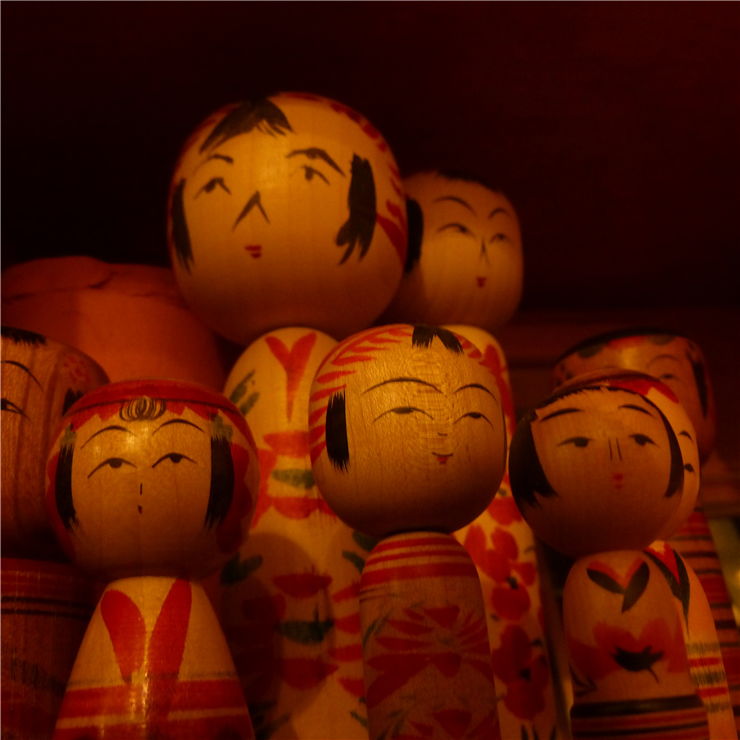Kokeshi - Meaning and Types of Kokeshi Dolls
Kokeshi are Japanese dolls, handmade from wood. Their origin is from northern Japan, Tohoku region, which is an area well-known for its hot spring resorts. Kokeshi is just a simple trunk with a big head. On that head, creator puts a few lines to define the face of the doll. Kokeshi's armless body is usually painted with floral design and then covered with a layer of wax. If an artist puts his signature, he does that on the bottom of the doll. Kokeshi probably were just souvenirs for Japanese tourists in the beginning, but today are artistic folk art.
The first kokeshi dolls were made during the middle of the Edo period (1600–1868), but it’s possible that they came much latter, in the early XIX century, when woodworkers began using their crafting skills to make something different, in this case, simple dolls, trying to sell them as souvenirs to the visitors of hot spring resort in Tohoku area. Origin of word 'kokeshi' is also unknown - it could be some combination of names given to the dolls in the different areas of their manufacture.

Kokeshi were first produced at the Shinchi Shuraku, near the Tōgatta Onsen in Zaō, from where kokeshi-making techniques spread to other areas popular among tourists in the Tōhoku region. Because of that, there's logical assumption that kokeshi weren't just souvenirs for tourists, but also a massage tool which was used in bathing in this spa region. The shape of kokeshi is ideal for massage.
Types of Kokeshi Dolls
There are two kinds of kokeshi dolls - traditional kokeshi and much new creative kokeshi.
Traditional Kokeshi
"Traditional" Kokeshi dolls are very simple in their shape and coloring. They always have round head and cylindrical body without arms nor legs. The coloring is also simple, so they are crafted in only three colors red, black and yellow. The floral and linear patterns which crafters paint on kokeshi's parts are developed through generations of kokeshi makers, but they are very distinctive to the area where they are made. The design of the doll is different in different parts of the region, but at the same time, always the same. There are eleven types of traditional kokeshi, from which is the most dominant type the Naruko. Naruko is originally made in Miyagi Prefecture. (Logically, the main street of the Naruko Onsen Village is known as Kokeshi Street and has shops where the kokeshi carvers work) .
Modern Kokeshi
There is also the "creative" type of kokeshi, developed after World War II. This type allows total creativity to the artist about shape, design and even color. These Kokeshi are reconverted to look more like human ― they are more shaped, and a cylinder (body of the doll) is often painted to give a better look of arms and clothing. Sometimes they even have fixed hair which stands separately from the head. There are no limits. The only rule is creativity, so "creative" kokeshi has many many colors, patterns, and styles of kimono. There are no rules about shape and size of these dolls, too.
The wood used in the creation of kokeshi can be cherry, dogwood or Japanese maple. There is a special type of the wood often used to make the kokeshi doll's face, called mizuki, and it literally translates as "water tree", so there are spiritual interpretations of kokeshi, in which having a kokeshi in the house helps in prevent fire. For the making of kokeshi, craftsmen and artisans use wood that has been seasoned for several months or even several years. The head and body of kokeshi are generally turned separately in manufacturing and then attached by way of a plug. An interesting fact is a face of the doll being hand painted in the end, and because of that, no two expressions of the kokeshi are ever the same.
Craftsmen from all over Japan gather every year in September at the Museum in the Naruko thermal bath to join the competition for the most beautiful Kokeshi doll, awarded directly by the Prime Minister.
